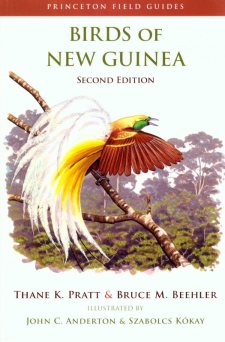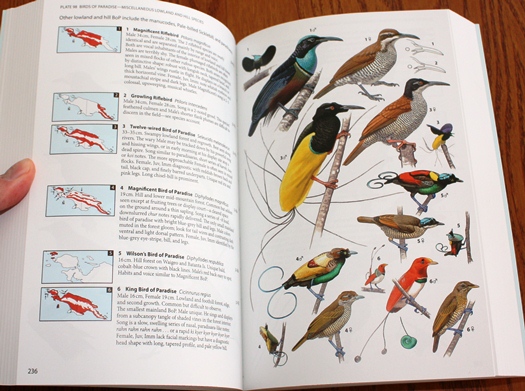Reviewed by Frank Lambert on January 25th, 2015.
New Guinea is not only the world’s second largest island, but, due largely to its spectacular topography, it supports one of the richest tropical environments in the Old World. Because of its long period of isolation, the avifauna has radiated to produce some of the most spectacular and sought-after birds on the planet, of which the birds of paradise and bowerbirds are undoubtedly best known. Others include the cassowaries, various megapodes, a wealth of unusual and colourful pigeons and parrots, numerous forest kingfishers, nearly all of the world’s owlet-nightjars, and a whole host of skulking interior forest species, such as jewel-babblers, melampittas, and Australian robins. With so much on offer, it is no wonder that bird tours to Papua New Guinea, and to a lesser extent West Papua (part of Indonesia), have become very popular.
Until now, however, the only field guide that one could use in the vast New Guinea region – including the West Papuan islands of Kofiau, Salawati, Batanta and Waigeo, the Geelvink islands such as Biak and Numfor, and the Milne Bay islands southeast of Papua New Guinea, as well as the island of New Guinea itself – was the 293-page-long first edition of this book. This was (and still is!) an excellent field companion, but since it was published some 28 years ago it is now very dated. My battered and annotated copy of that edition, first used on a 1987 trip to what was then Irian Jaya (now West Papua), has long been one of my most prized bird guides, and I am very happy to finally be able to replace it with an affordable, fully-revised edition. This new edition of Birds of New Guinea is the only guide to cover all 780 bird species reported in the area, including a staggering 366 endemics.
The first edition contained no range maps and eight of the 55 Plates were in black-and-white. The second edition, as you would expect, is nothing like this – indeed, it is an incredibly good field guide, meeting all the expectations that you might have for a regional bird guide. Unlike the first edition, which merely contained some poorly-detailed maps, the inside front cover now features a detailed map of western New Guinea (part of Indonesia) whilst the back cover shows the eastern part (Papua New Guinea). As one would anticipate, the first part of the book (p 14-40) provides a succinct introduction to the region, with sections on climate, biogeography, rainforest ecology, and conservation. There is also a ‘how to use’ section, and an ‘in the field searching for birds’ section.
The key features of this field guide, however, are the 111 colour plates—twice as many as the first edition, all of which are new, and the range maps. Nearly all of the illustrations are by John Anderton, along with some by Szabolcs Kokay, two by John Coe, and one by Dale Zimmerman (who did most of the artwork for the first edition). The illustrations are very pleasing and the plates are generally well laid out. As with any modern guide, distinctive subspecies or plumages are illustrated where necessary.
Facing each plate is a brief description of each illustrated species along with a detailed colour range map. These maps, 635 in all, show the ranges of all resident species in detail and these are zoomed in on the very specific range of some restricted-range species. The only instances where there are no maps are opposite those plates that depict birds in flight or most of the shorebirds (these being passage migrants). Maps are coloured to represent status, although there is no particular colour to indicate the species that are regional endemics, something that would have been appreciated by many.
In the last 28 years, a considerable amount of new information on the birds in the region has been amassed, and the species accounts have been fully revised to reflect this and now cover some 450 pages. In this section [which is separate from the plates and makes up about half of the book -ed.], each family is introduced with several paragraphs on their natural history within New Guinea and how and where to see them. Individual species accounts incorporate new information about identification, similar species, voice, habits, and range. Of course the taxonomy has been revised to reflect the numerous changes that have occurred since 1986, and many species accounts include relevant taxonomic notes. The taxonomy is largely based on IOC but has been modified by the authors in places, based on their considerable field expertise.
Anyone who picks up a copy of this wonderful field guide is certain to quickly realize that Birds of New Guinea remains an indispensable field guide to the birds of this extraordinary region. As such, it is a must-have book for anyone interested in the birds of Papua New Guinea, West Papua, or Indonesia.
– Reviewed by Frank Lambert







For anyone heading there it will be extremely helpful. I went last summer and we had to cobble together resources from out of print editions (which were running very expensive on the web) to screen shots compiled from various online resources. The book is heavy, so take that into account because of weight restrictions when you travel, but I wish someone had had it.
[…] Birds of New Guinea (Second Edition) January 25, 2015 (The Birder’s Library) […]